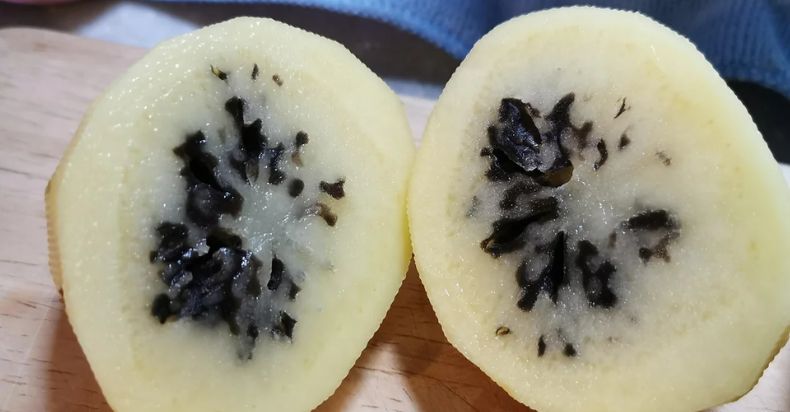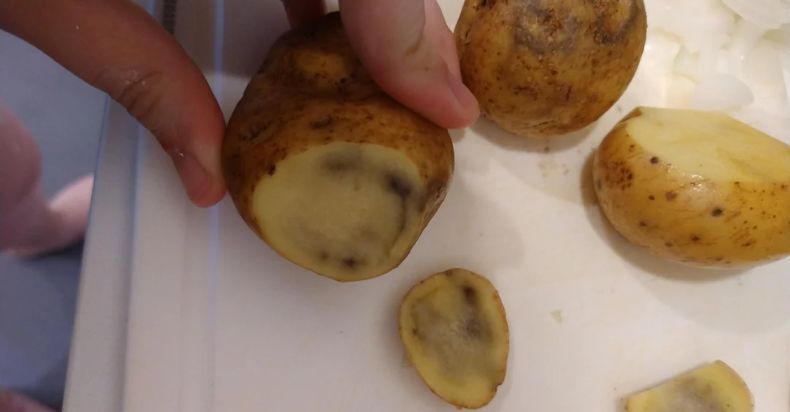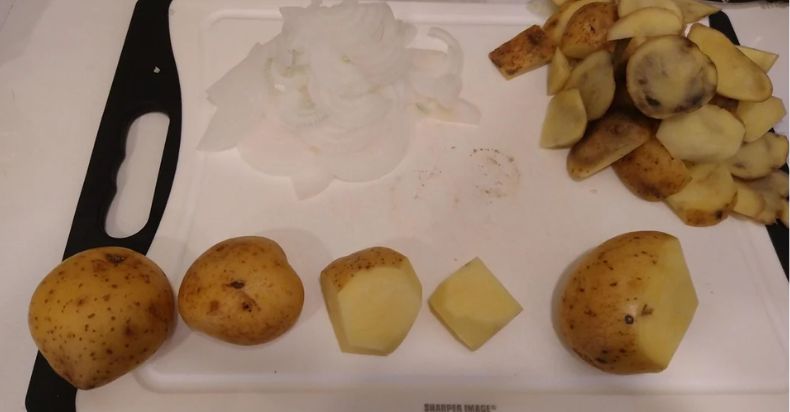Hey there, potato lover! Ever pulled out a potato from your pantry, all set to whip up some delicious fries or a comforting mash, only to find it sporting some unsightly brown spots?
Yeah, we’ve all been there. It’s a bummer, right? But what exactly causes these brown spots on potatoes? Is it something you did? Or didn’t do? Or is it just the potato being a drama queen? Let’s dig in and find out!
What Are These Brown Spots?

Okay, so you’ve just sliced open a potato and you’re greeted with a surprise – brown spots. But what exactly are these spots? Let’s dive in and find out!
Firstly, it’s important to note that not all brown spots are created equal. They can vary in size, color, and location, and they can appear both on the potato’s skin and inside its flesh.
But one thing’s for sure – they’re not what you want to see when you’re prepping your potatoes for dinner!
1-Surface Spots:
These are the spots you see on the skin of the potato. They can be small and speckled or larger and more noticeable.
These spots are often the result of bruising or scab disease. The potato’s skin is its first line of defense against the outside world, and when it gets damaged, brown spots can form.
2-Internal Spots:
When you cut open a potato, you might see brown spots inside the flesh. These spots can be small and isolated, or they can form larger, more irregular patterns.
These spots are often the result of age or internal diseases like blackleg or internal brown spot.
3-Hollow Heart:
This is a special kind of internal spot that deserves its own mention. Hollow heart is a condition where a cavity forms in the center of the potato, often surrounded by a ring of brown discoloration.
This condition is usually caused by fluctuations in growing conditions, like inconsistent watering or a sudden growth spurt.
4-Green Spots:
While not brown, it’s worth mentioning green spots as well. These spots are caused by exposure to light, which causes the potato to produce chlorophyll (which is green) and a toxin called solanine.
Solanine can cause the potato to develop brown spots and is harmful if ingested in large amounts.
So, those brown spots on your potatoes, they’re a sign that something’s up – whether it’s age, disease, poor storage conditions, or something else entirely.
But don’t worry, we’ll get into how to prevent these spots in the next sections.
Causes of Brown Spots on Potatoes:

Alright, let’s get down to the root of the matter and explore the reasons behind those pesky brown spots on your potatoes.
There are several culprits that could be responsible, and understanding them can help you prevent these spots in the future. So, let’s get started!
1-Bruising:
Potatoes, like peaches or apples, can bruise. This usually happens when they’re handled roughly or dropped.
The impact damages the potato’s cells, leading to a chemical reaction that causes discoloration.
This bruise will appear as a brown spot on the potato's skin or just beneath it. So, next time you're unloading your groceries, be gentle with your spuds!
2-Age:
Ageing is a natural process that affects all living things, including potatoes.
As potatoes age, they can develop brown spots both on their skin and inside.
These spots are usually a sign that the potato is past its prime and starting to spoil. If you cut open a potato and it has a lot of brown spots inside, it’s best to toss it.
3-Disease:
Several diseases can cause brown spots on potatoes. Common scab, caused by the bacterium Streptomyces scabies, results in rough, scaly spots on the potato's skin.
Another disease, blackleg, caused by a type of fungus, can cause dark spots to appear on the potato’s skin and flesh.
If you notice these signs, it’s best not to eat the potato as these diseases can make you sick.
4-Storage Conditions:
Potatoes are a bit like Goldilocks – they need their storage conditions to be just right. If potatoes are stored in conditions that are too warm, they can sprout and develop spots.
If they’re stored in conditions that are too cold, the starches inside the potato can turn to sugar, leading to brown spots.
And if they’re exposed to too much light, potatoes can turn green and develop a toxin called solanine, which can cause brown spots and is harmful if ingested in large amounts.
5-Nutrient Deficiencies:
The conditions in which a potato is grown can also affect its appearance.
For instance, a lack of certain nutrients in the soil, like calcium, can lead to a condition called internal brown spot.
This condition causes brown spots to form inside the potato, making it unappealing to eat.
Also, factors such as soil pH, moisture levels, and temperature can all play a role in the development of these spots. For instance, potatoes grown in highly acidic or overly moist soils are more prone to developing these blemishes.
READ: 9 Surprising Reasons Why Your Mango Is Brown Inside
How to Prevent Brown Spots on Potatoes?

Alright, so now that we know what cause these pesky brown spots, let’s get to the good stuff – how to prevent them!
Because let’s face it, nobody wants to deal with brown spots when they’re just trying to make some delicious mashed potatoes or crispy fries.
So, here are some tips to keep your potatoes spot-free:
- Proper Storage: This is a biggie. Potatoes should be stored in a cool, dark, well-ventilated place. The ideal storage temperature is around 45-50°F (7-10°C). Too cold, and the potato’s starches convert to sugars, giving them a sweet taste and causing them to brown excessively when cooked. Too warm, and the potatoes will sprout and shrivel. And remember, never store potatoes in the fridge or in plastic bags – they need ventilation to prevent moisture build-up and subsequent rot.
- Handle with Care: Potatoes can bruise easily, and bruising can lead to brown spots. So, handle your potatoes gently to prevent damage. This is especially important during harvest and when moving them to storage.
- Buy Disease-Free: If you’re growing your own potatoes, make sure to buy disease-free seed potatoes. This can help prevent diseases that cause brown spots, like potato scab or blackleg.
- Rotate Crops: Another tip for home growers – rotate your potato crops. Planting potatoes in the same spot year after year can lead to a build-up of diseases in the soil.
- Check for Damage: When buying potatoes, check for any visible damage or discoloration. Damaged potatoes are more likely to develop brown spots during storage.
- Avoid Light Exposure: Remember those green spots we talked about? You can prevent them by keeping your potatoes out of the light. Light exposure causes potatoes to produce solanine, which can lead to brown spots.
- Use Quickly: The longer potatoes are stored, the more likely they are to develop spots. So, try to use your potatoes within a few weeks of purchase or harvest.
By following these tips, you can keep your potatoes looking spot-free and ready for all your culinary adventures.
Now, go forth and make those perfect, spot-free mashed potatoes you’ve been dreaming of!
To Eat or Not to Eat?
Here’s the million-dollar question: Can you eat a potato with brown spots? The answer is… drumroll, please… mostly yes!
Just cut out the brown spots and cook the rest as usual. But if the potato smells off or if the spots are accompanied by mold, it's time to say goodbye.
Key Takeaways
- Brown spots on potatoes are often just bruises.
- Green spots indicate the presence of solanine, a toxin.
- If the potato smells off or has mold, toss it.
- When in doubt, cut out the brown spot and enjoy the rest!
So, there you have it! A comprehensive look at why your potatoes might be turning brown.
Remember, while some brown spots are harmless, others can be a sign of spoilage or disease.
When in doubt, it’s best to err on the side of caution and not eat the potato. After all, better safe than sorry!
